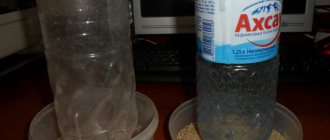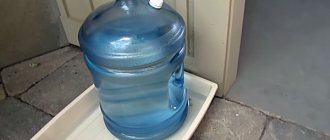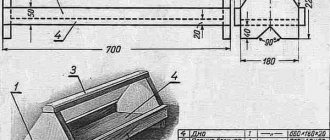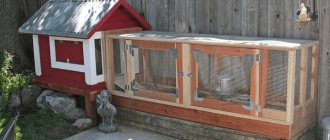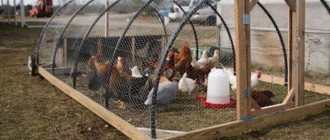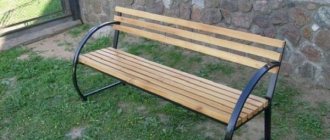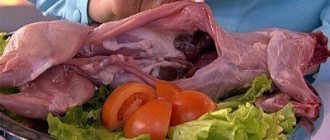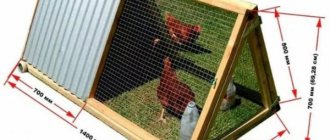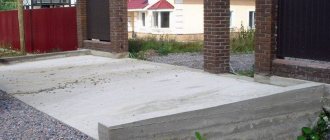» Poultry farming » Chickens » Feeders for chickens from sewer pipes
0
1663
Article rating
Classic methods of feeding poultry are often inconvenient and ineffective. A homemade chicken feeder made from a sewer pipe is practical, affordable, easy to make and does not require large material costs.
Chicken feeders made from PVC sewer pipes are convenient and practical
Requirements for hand-made devices
Homemade devices for feeding poultry should be:
- mobile and collapsible so that they can be easily cleaned;
- spacious so that there is enough food for all individuals at once;
- have an approach from all sides to prevent the displacement of weaker individuals, who may ultimately remain hungry;
- have restrictions so that chickens cannot climb and rummage in the feeder;
- have places for feeding at the rate of 10-15 cm in length for each individual (for chickens 5-10 cm).
We make the feeder ourselves
Despite the fact that homemade bird feeders cannot boast of high aesthetic qualities, they do an excellent job of their task: they provide food for poultry for a long time.
We bring to your attention two options for “feeding dishes” that can be made without much effort, using a minimum of materials and time.
From a plastic pipe with a tee
For this option you will need:
- pipe 1 m long;
- plugs;
- 45 degree tee;
- brackets.
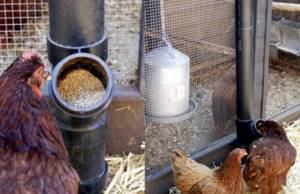
The design of the feeder includes several stages:
- Two pieces of 20 cm and 10 cm are cut from the pipe.
- A plug is attached to one side of the product (20 cm). This will serve as the bottom of the feeder.
- A tee is attached to the other side, with the side elbow up.
- The smallest section (10 cm) is installed to the side knee.
- The remaining long piece of PVC is attached to the third hole of the tee.
- Fix the structure in the right place.
- The end where the food is poured is covered with a plug.
Read also: Nematanthus: home care, types, reproduction, transplantation
From a plastic pipe with holes
It is quite possible to build a bird feeder quickly and efficiently if you stock up on the following materials:
- two PVC pipes of 50 cm, one - 30 cm;
- two pipe plugs;
- knee.
During the work process, you will also need a drill to drill a hole.
The design manufacturing algorithm is as follows:
- Holes with a diameter of about 7 cm are drilled in the lower pipe on both sides.
- On the opposite side, the structure is closed with plugs.
- The free part is connected to the short section using an elbow.
- The result is a design in the form of an inverted letter G.
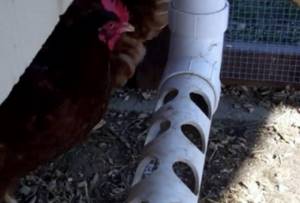
Feed will be supplied through the short part of the feeder.
Advantages of homemade products
According to the responses of experienced farmers, a chicken feeder made from a sewer pipe:
- the most reliable and durable.
- has virtually no shelf life and does not react with liquid food.
- easy to make (done in a couple of hours and easily attached to the wall);
- can hold up to 10 kg of feed at a time, which eliminates the need to constantly go to the chicken coop and add food;
- can serve about 20 heads simultaneously;
- the cheapest, since it is usually made from home renovation waste, but a new one in the store is inexpensive.
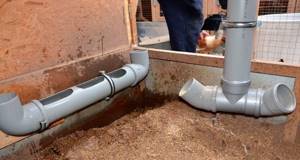
Other advantages of homemade products include providing uniform nutrition to the livestock, which is extremely beneficial for their health. The chickens quickly realize that there are no interruptions in the coma supply and stop crowding around the feeder, fighting for food and creating a nervous atmosphere in the chicken coop. The latter is especially important if there are laying hens in it.
Classification
Let's consider the types of feeders according to the type of installation, they are divided into:
1. Suspended. 2. Attached to the wall. 3. Placed on the floor. In this form, as a feeder made of PVC pipes attached to the wall, to install the system, special brackets are used, which are attached to the bars of the grille or to the wall itself.
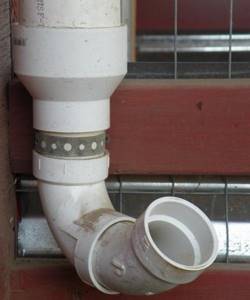
If chickens need to eat the green variety, it is recommended to serve it in a mesh-shaped feeder. You can put food and grass there through the spaces between the mesh bars. The chicken food product is always kept fresh and ready for use, because it is protected from the ingress of all kinds of poultry waste products. Also, professionals and farmers prefer to use wall-hung feeders or floor-mounted mesh feeders. Having considered the types of food that will serve as a product for your animals, they can be divided into two subtypes - these are feeders for dry and wet food. To use wet feed, it is recommended to use iron alloy feed systems because this type is easy to clean and disinfect. If a niche is needed for dry food, then you can use both metal and plastic feeders. Types of feed devices according to the supply system: 1. In the form of a chute. 2. In the form of a tray. 3. In the form of a bunker or automatic feeder.
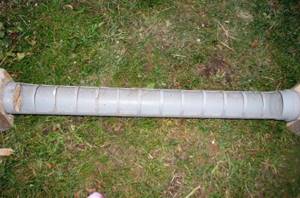
Feeder in the form of a tray
makes it possible to set boundaries for food, that is, it has a special restrictive part with it that does not allow the bird to scatter food on the ground.
This type of feeding system is recommended for use for small hens, that is, for chicks, both dry and wet types of food can be poured into it. The niche in the form of a gutter
has a special grille that can be removed at the right time.
These plates and grates prevent the bird from introducing contaminants into it when it pokes its head in to eat. This type usually has several feed compartments. These feeders should be attached to the outer walls of the cage and are also very easy to wash and add complementary food to. An automatic feeder or hopper type
includes a niche and a hopper into which food is poured. It works in the following way: if the chickens have eaten their portion of food and there is nothing left in the tray, then the hopper fills the niche with food again. Having discussed this type, we conclude that the farm worker will not waste time filling the niche. This feeding method is suitable for all types of complementary foods, as well as for all types of chickens of any age.
We recommend: PVC pipes for internal sewerage: technical characteristics
Types of homemade products and methods of making them
The most common types of plastic pipe feeders are:
- vertical;
- horizontal;
- bunkers.
Vertical system
For production you will need:
- sewer pipe with a diameter of 110 mm;
- tee of the same diameter up to an angle of 45°;
- plugs of the same diameter;
- a tool for cutting plastic, such as a hacksaw.
Step-by-step instruction:
- Take a meter long pipe and cut it into 3 parts (70, 20 and 10 cm).
- Place a plug on the bottom of the 20 cm long part. and on top there is a tee. He should "look" up. This is the basis of the design.
- Insert a short piece (10 cm) into the side knee.
- Attach the longest piece (70 cm) to the structure, and use the second plug as a lid.
- Now attach the finished feeder using clamps to a reliable support or secure it to the wall.
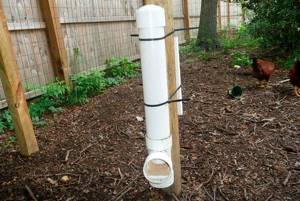
The food is served from above; a lid is necessary to prevent dirt from getting inside; the chickens will peck food from the side holes. The feed in such a device is enough for 15-20 chickens for a day.
Horizontal
To make a horizontal system, you will need a pipe about 2 meters long and 110 mm in diameter, as well as an elbow and one plug of the appropriate diameter. The tools you will need are a jigsaw, a drill and a hacksaw.
Step-by-step instruction:
- Cut the pipe into 2 equal parts.
- Cut holes in one of the parts. A simpler option is to cut one simple long hole, but in this case the chickens will climb on top, throw the food around and dirty it. Therefore, it is more advisable to mark several 10-15 cm windows on the pipe and carefully cut them out: first drill holes with a drill, and then finish the job using a jigsaw.
- Close the elbow with the holes on one side with a plug and use the elbow to attach (vertically) the second section to the other.
- Secure the chicken feeder made of plastic pipes to the wall using clamps.
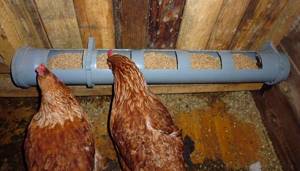
If desired, you can attach another elbow to the upper end of the vertical part and move the feed receiver outside the fence. The principle of operation and the number of chickens served are the same as in the previous version.
Bunker
To make this variation you will need:
- two pipes: one 10-15 cm long and 200 mm in diameter and the second about 25-30 cm long and 32 mm in diameter.
- a sheet of plywood with a size of at least 30x30 cm and a thickness of 10 mm (the latter parameter may be larger, the stability of the entire system depends on it);
- plastic canister for 10-15 liters.
Step-by-step instruction:
- Secure the thick pipe to the plywood using metal corners. They should be placed opposite each other and secured with screws.
- Take a thin pipe and make a longitudinal cut from the end in the center by 10-15 cm.
- On a narrow pipe, make a transverse cut so that half of the pipe at the bottom is cut off.
- Insert the narrow pipe with the cut end into the wide one and secure them with bolts or self-tapping screws;
- Cut off the bottom of the canister, and fit the neck tightly onto the thin part of the pipe.
To further protect the resulting bunker from overturning, make a hole in the top of the canister, stretch a rope and tie it to some reliable support.
A hopper with a 6-liter canister is enough to feed 30 broilers daily. In this case, you only have to refill it once.
We recommend that you read other articles on the topic of homemade feeders and drinkers for chickens: “Do-it-yourself waterer for broiler chickens”, “Do-it-yourself feeder for broiler chickens”.
Design Features
When choosing a design for feeding chickens, it is worth considering some points:
- a feeder made of PVC sewer pipes must provide food for the entire chicken population, therefore the distance between the feed holes on the main pipe is from 10 to 15 cm per head, for broilers this distance is increased, for chickens the gap is reduced by 2 times;
- the longer the components made from the pipe, the more feed mixture is placed there;
- when installing a feeding structure in a specific place, it is chosen so as to provide free access to it for all birds;
- limiters prevent birds from entering the feeder;
- The product is made mobile and easy to assemble and disassemble, which allows for regular cleaning.
Bird feeder and drinker made from plumbing pipe
Pros and cons of feeders and drinking bowls made of plastic pipes
Feeder for chickens from a pipe
conclusions
- Homemade feeders for broilers are cheap, reliable and practical.
- Their production will take no more than 1-2 hours and will save a lot of time for the farmer, saving him from constantly running to the chicken coop to add feed.
- Homemade products have a beneficial effect on the psychological climate in the chicken coop, which is especially important if there are laying hens or chickens there. Realizing that there is always food, the birds stop fighting for food, making noise, and pushing out the weak.
- Feeders for broilers made from a sewer pipe allow you to significantly save on feed, since the chickens eat as much as they need, but do not contaminate the feed, do not overturn the feeders, do not rummage through them, scattering food in all directions.
Manufacturing
If you want to make your own chicken feeder, choose several simple options.
Most often, homestead farms make feeders from PVC pipes, because... This is a simple and accessible material.
With cutouts
To make such feeders with your own hands, you need a minimum of materials and tools.
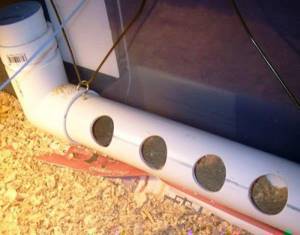
Feeder with cutouts
Prepare in advance everything you need:
- tools for work;
- 2 PVC pipes 60 cm and 40 cm long;
- elbow, which is necessary for connection;
- 2 plugs, which are selected according to size.
The procedure for working on a chicken feeder.
A 60 cm pipe (horizontal) is needed for feeding chickens, a second (vertical) is needed for feeding feed.
Cut holes on the first one. But instead, they make one solid one, through which the chickens peck food.
- First, on a 60 cm pipe, draw holes that will be cut out, 7 cm wide.
- The drawn holes are cut out.
- A plug is placed on one end of the pipe.
- Attach a knee to its other end. Insert the second pipe into it.
- The work is done. Now the structure needs to be secured in the chicken coop, preferably in several places, so that it holds. You pour the food into a vertical pipe and put a cap on it to prevent debris from getting inside. When the chickens eat the food that has penetrated downwards, a new portion of food will immediately fall out, and your pets will always be full. All you have to do is go into the chicken coop once a day and fill the feeder.
With tee
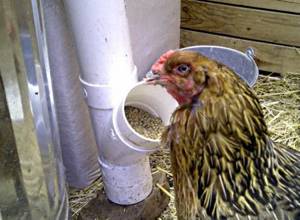
Feeder with tee
To make this chicken feeder you will need:
- tools;
- They are made from PVC plastic pipe. You can take one and cut it into pieces, or pick up ready-made ones and cut them to size. If you are cutting pipes, you can change the dimensions, but it is advisable to maintain the proportions: 10, 20, 70 cm.
- tee with an angle of 45;
- 2 plugs for plastic pipe;
Read also: Brazil nuts - benefits, harm, composition and calorie content
How to make such a feeder with your own hands:
- Take a medium-sized pipe and put a plug on one end. This is the very bottom of our design.
- You need to put a tee on its other end so that the side knee looks up;
- Now you need to insert a small pipe into the side hole.
- The longest one is inserted into the remaining hole of the tee.
The chicken feeder is ready. You can fill in the food and close the hole with a plug. Chickens will be able to peck food from the resulting small hole.
There are simpler ways to make feeders with your own hands. Experienced chicken breeders tell you how to make them in this video. Use their advice or the instructions given above.
Can I buy it in stores?
The choice of feeders in stores starts from the simplest bunkers to high-tech devices with a timer and a feed scattering function.
The price for the simplest bunker feeders is approximately 500-1000 rubles, but for high-tech products you will have to pay 5000-6000 rubles. The body material of the feeders also affects the price. A feeder made of ABS plastic costs 6.5 thousand rubles. Made of powder-coated steel 8.5 thousand rubles.
Read also: Bergamot: beneficial properties and contraindications
In stores you can find feeders completely ready for installation and use. They immediately have a food container and a tray.
It’s even better to make a feeder yourself from scrap materials. This will cost much less and will correspond to the number of birds.
How to do it yourself?
The shape of the feeder is similar to the Latin letter L. The vertical pipe serves as a hopper for loading feed. The horizontal pipe will be the feeding place:
- On a pipe 80 cm long, mark the centers of the holes.
- We draw holes D=70 mm. Leave the distance between the edges of the holes 70 mm. The holes can be in two rows.
- Using an electric drill with a circular bit, we make holes in the pipe.
- We process the holes with a file so that the chickens do not cut themselves on the burrs.
- We put a plug on one side of the pipe, and an elbow on the other side.
- We thread a vertical pipe into the elbow.
- We attach the structure to the wall.
With slots
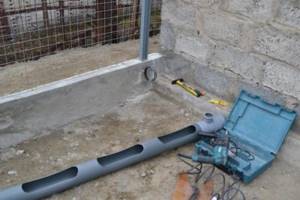
Along a pipe 80 cm long we draw two parallel lines at a distance of 5 cm from each other.- We take a wooden block-pattern with dimensions of 10x5 cm and outline the places of future slots on the pipe. Leave the distance between the slots 5 cm.
- Drill a hole in the corner of each drawn rectangle.
- Using a jigsaw we cut out the slots.
- We clean the edges with a file.
- We put a plug on one end of the pipe and an elbow on the other.
- We insert the vertical pipe into the elbow.
- We attach the structure to the wall.
Watch a video about making a chicken feeder from a PVC pipe with slots:
With tee
- We put a plug on a pipe 20 cm long. This will be the lowest part of the structure.
- On the other side, we put on the tee so that the outlet faces up.
- We put a short pipe of 10 cm on the tee outlet.
- We insert the remaining 150 cm pipe into the upper hole of the tee.
- We attach the structure to the wall.
After attaching to the wall, any feeder is immediately ready for use. The required amount of grain or mixed feed is poured on top and the hole is closed with a plug so that debris does not get into the bunker and the feed does not get wet during rain.
Watch a video about a chicken feeder made of PVC pipes with a tee:


